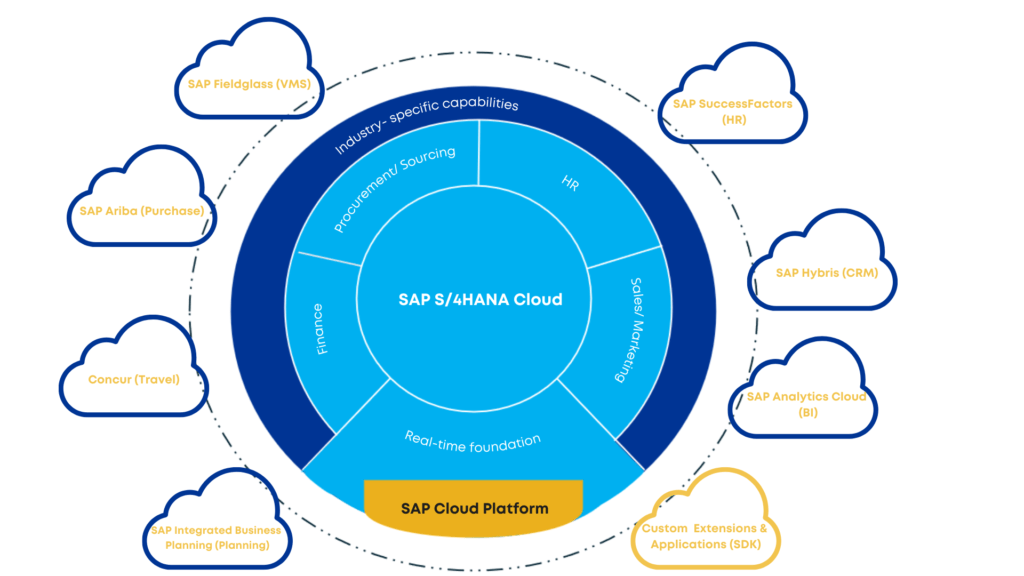Are You Ready to Move to the Cloud? Navigating SAP S/4HANA Deployment Options

In the realm of enterprise resource planning (ERP) solutions, SAP S/4HANA offers businesses unparalleled capabilities for streamlining operations and driving growth. However, the decision between on-premise and cloud deployment presents a critical choice with far-reaching implications. In this guide, we explore the key considerations and differences between these deployment options, empowering businesses to navigate the path towards digital transformation effectively.
Let’s delve into the nuances of each deployment option, uncovering the unique features, benefits, and considerations that shape this pivotal choice.
SAP S/4HANA On-Premise: Empowering Control and Customization
SAP S/4HANA On-Premise represents the traditional yet robust approach to ERP deployment. It serves as the foundation for the SAP ERP Business Suite, leveraging the powerful SAP HANA in-memory database platform. This internal platform resides on the company’s own servers, affording full control and management over critical components, including the HANA database, applications, servers, networks, and related systems. With on-premise deployment, organizations retain autonomy and flexibility, enabling tailored customization to meet unique business needs. However, this autonomy comes at the cost of increased infrastructure investment and the need for dedicated IT resources to manage and maintain the system.
SAP S/4HANA Cloud: Embracing Scalability and Convenience
In contrast, SAP S/4HANA Cloud represents the epitome of agility and scalability in ERP deployment. As a Software as a Service (SaaS) solution, it offers businesses the opportunity to leverage SAP S/4HANA functionality without the burden of hardware provisioning, database management, or internal IT support. With SAP managing everything from applications to data, runtime, middleware, and infrastructure, organizations can focus on driving business innovation without being encumbered by technical complexities. While cloud deployment streamlines operations and ensures automatic updates for the latest software version, it relinquishes some control over system management to a third-party provider.
Key Considerations: Licensing Models and Business Processes
One of the primary factors influencing the deployment decision is the licensing model. SAP offers distinct licensing models for each deployment option: perpetual licensing for on-premise deployments and subscription-based licensing for cloud deployments. While on-premise licensing provides perpetual usage rights, cloud subscriptions offer flexibility in duration, catering to varying business needs.
Additionally, the choice between on-premise and cloud deployment impacts business processes, infrastructure requirements, and customization capabilities. On-premise deployment grants organizations greater control over infrastructure and customization but entails higher upfront costs and longer implementation timelines. In contrast, cloud deployment accelerates implementation and ensures automatic upgrades but limits customization options and requires ongoing subscription fees.
Integration and Support: Ensuring Operational Efficiency
Both SAP S/4HANA deployment options seamlessly integrate with essential business applications such as SAP SuccessFactors, SAP Hybris, SAP Fieldglass, SAP Jam, and SAP Ariba, facilitating holistic operational efficiency. However, the level of support and upgrade management varies between on-premise and cloud deployments. On-premise deployments afford organizations greater control over upgrade schedules and support package implementations but demand internal resources for maintenance and upgrades. In contrast, cloud deployments offer automatic upgrades and comprehensive support packages, minimizing operational disruptions but relinquishing control over upgrade schedules to the cloud provider.
Cost Analysis: Balancing Investment and Return
Finally, cost analysis plays a crucial role in the deployment decision. On-premise deployments entail upfront investments in hardware, infrastructure, and IT resources, while cloud deployments feature subscription-based pricing with ongoing operational expenses. To accurately assess the total cost of ownership (TCO), organizations must consider factors such as infrastructure costs, subscription fees, support services, and long-term scalability.

The conclusion
As organizations navigate the SAP S/4HANA deployment dilemma, it’s essential to weigh the benefits, considerations, and trade-offs associated with each deployment option. Whether prioritizing control and customization through on-premise deployment or embracing scalability and convenience with cloud deployment, the key lies in aligning the chosen approach with strategic objectives, resource capabilities, and business priorities. With SAP S/4HANA paving the way for digital transformation, businesses stand poised to embark on a journey of innovation and growth, charting a course towards operational excellence in the digital era.
Allow our team of experts to guide you through every step of this S/4HANA journey. Together, we’ll explore the best cloud solution specifically for your firm’s needs. Click here to visit our contact subpage and reach out to us today for the best SAP migration methods!